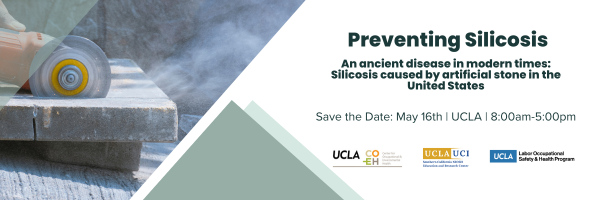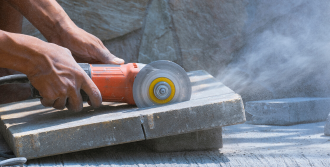Preventing Silicosis Conference - May 16, 2024 at UCLA

The purpose of this conference is to bring together affected workers, employers and manufacturers with researchers, unions, community-based organizations and other stakeholders to develop practical and feasible solutions to prevent silicosis caused by artificial stone.
Key Questions:
- What factors are driving the current epidemic of silicosis among artificial stone workers?
- What are the needs of affected workers, employers, and silicosis patients?
- What research gaps exist?
- What interventions are available to protect workers and prevent new silicosis cases?
Desired Outcomes: Develop a research agenda and a concrete set of recommendations that could be implemented in the California context and shared with other impacted communities.
The conference's agenda, presentations, and meeting report and recommendations are available here.
California Passes Emergency Temporary Standard to Limit Silica Dust Exposure

Did you know? Silicosis is a disabling, nonreversible lung disease from exposure to silica dust, from cutting or grinding stone. A July 2023 paper showed a serious outbreak of young male Spanish-speaking countertop workers with severe silicosis in California. Those working with engineered stone countertop fabrication are advised to immediately look into their work practices and take precaution for breathing in silica dust.
An Emergency Temporary Standard has been passed in California that will last a year (in effect 12/29/23), with the hopes of a more permanent Standard developed by the time it ends. This initiative serves to protect workers from silicosis by working to decrease their exposure to respirable crystalline silica. This prohibits Dry Cutting and Dry Sweeping in countertop fabrication shops, among other requirements. Shops that don’t oblige face being closed.
In summary, some of the new Emergency Temporary Standard requirements are:
Methods of Compliance
- Use wet methods.
- Properly handle all waste materials.
- Monitor air to make sure silica dust levels are below a certain level.
- DO NOT use compressed air.
- DO NOT dry sweep.
- DO NOT allow employees or equipment to move through dust.
- DO NOT rotate employees to reduce exposure.
Respiratory Protection
- Use a full-face, tight-fitting, Powered Air-Purifying Respirator, or equal alternative.
- Use an organic vapor cartridge for artificial stonework.
- Use a supplied air respirator under certain conditions.
Housekeeping
- Enact safe clean-up methods.
Communicating with Employees
- Ensure training & information is appropriate for the language of employees.
- Include text about permanent lung damage and death in English and Spanish on signs posted.
- Train employees on symptoms and how to prevent exposures.
- Encourage reporting of symptoms without fear of retaliation.
Exposure Assessment
- Conduct exposure monitoring at least every year to assess effectiveness.
Silicosis Reporting
- Employers must report cases of confirmed silicosis or lung cancer to Cal/OSHA and CA Dept of Public Health.
See full Emergency Temporary Standard requirements and official Press Release.
Cal/OSHA Resources for Workers & Employers
- What Employers Need to Know: Silica Emergency Temp. Standard
- Information for Employers: Silica Emergency Temp. Standard
- Information for Workers: Silica Emergency Temp. Standard
- Respirable Crystalline Silica Standards & Resources
More California Dept of Public Health publications:
- Hazard Alert: Engineered Stone Countertop Fabrication
- Cal/OSHA Silica Standard cheat sheet
- Workplace Air Monitoring for Silica – Employer Guide
- Silica Safety Resources for Stone Fabricators
The Natural Stone Institute offers safety training for workers in the natural stone industry, and a 4-hour online Certificate that covers preventing silicosis, safe slab handling, and creating a safety program.
